oil DODGE GRAND CARAVAN 2009 5.G User Guide
[x] Cancel search | Manufacturer: DODGE, Model Year: 2009, Model line: GRAND CARAVAN, Model: DODGE GRAND CARAVAN 2009 5.GPages: 535, PDF Size: 18.61 MB
Page 261 of 535
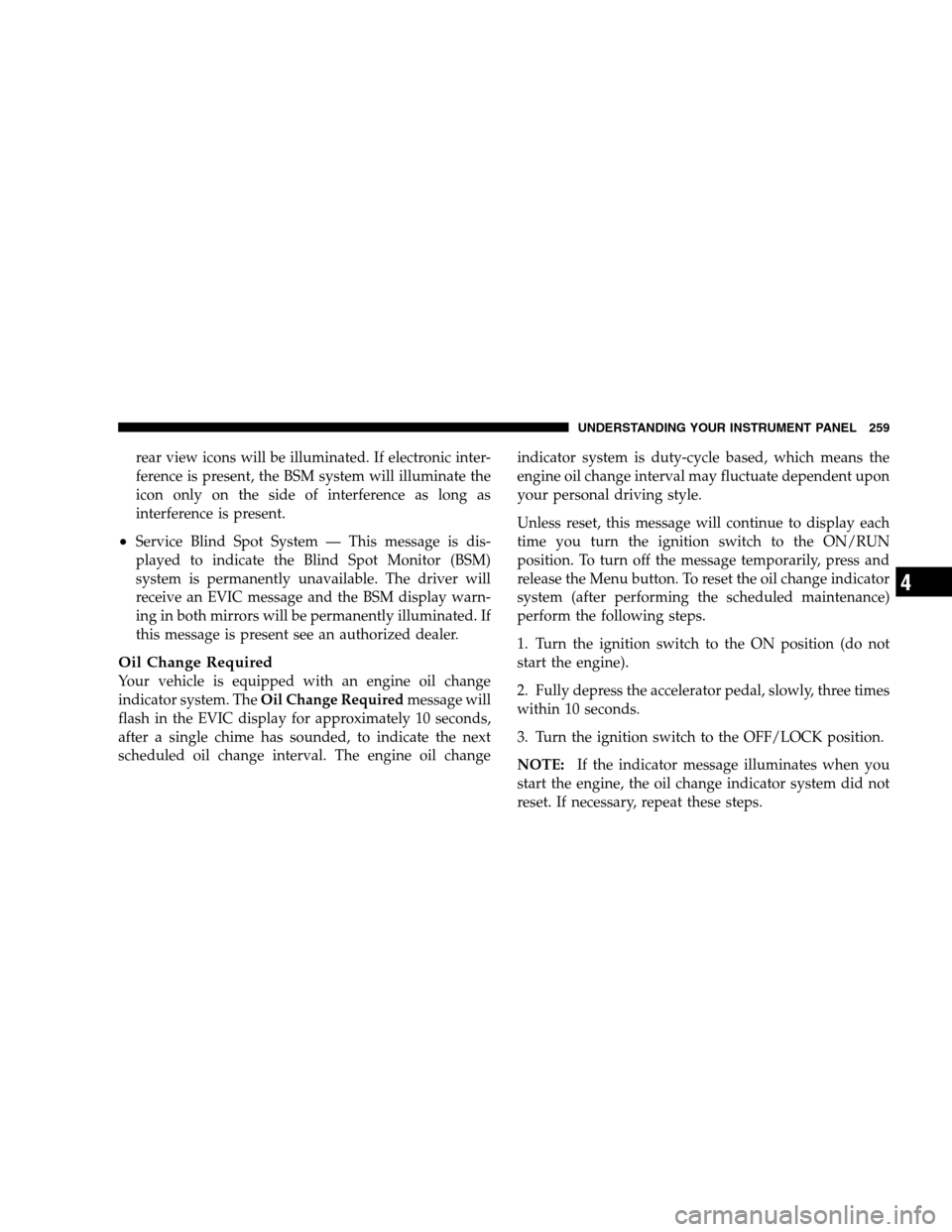
rear view icons will be illuminated. If electronic inter-
ference is present, the BSM system will illuminate the
icon only on the side of interference as long as
interference is present.
Service Blind Spot System — This message is dis-
played to indicate the Blind Spot Monitor (BSM)
system is permanently unavailable. The driver will
receive an EVIC message and the BSM display warn-
ing in both mirrors will be permanently illuminated. If
this message is present see an authorized dealer.
Oil Change Required
Your vehicle is equipped with an engine oil change
indicator system. TheOil Change Required message will
flash in the EVIC display for approximately 10 seconds,
after a single chime has sounded, to indicate the next
scheduled oil change interval. The engine oil change indicator system is duty-cycle based, which means the
engine oil change interval may fluctuate dependent upon
your personal driving style.
Unless reset, this message will continue to display each
time you turn the ignition switch to the ON/RUN
position. To turn off the message temporarily, press and
release the Menu button. To reset the oil change indicator
system (after performing the scheduled maintenance)
perform the following steps.
1. Turn the ignition switch to the ON position (do not
start the engine).
2. Fully depress the accelerator pedal, slowly, three times
within 10 seconds.
3. Turn the ignition switch to the OFF/LOCK position.
NOTE:
If the indicator message illuminates when you
start the engine, the oil change indicator system did not
reset. If necessary, repeat these steps.
UNDERSTANDING YOUR INSTRUMENT PANEL 259 4
Page 329 of 535
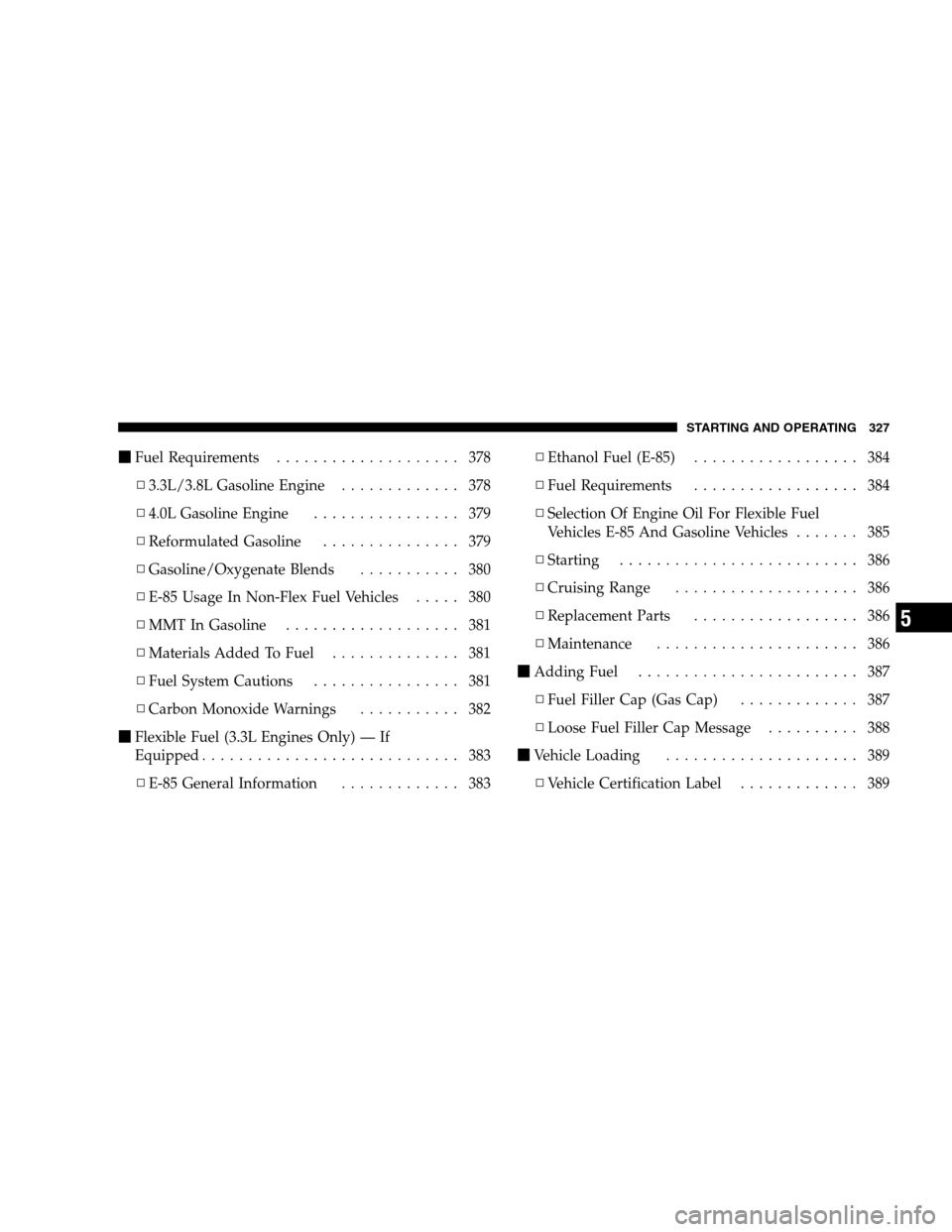
mFuel Requirements . . . . . . . . . . . . . . . . . . . . 378
▫ 3.3L/3.8L Gasoline Engine . . . . . . . . . . . . . 378
▫ 4.0L Gasoline Engine . . . . . . . . . . . . . . . . 379
▫ Reformulated Gasoline . . . . . . . . . . . . . . . 379
▫ Gasoline/Oxygenate Blends . . . . . . . . . . . 380
▫ E-85 Usage In Non-Flex Fuel Vehicles . . . . . 380
▫ MMT In Gasoline . . . . . . . . . . . . . . . . . . . 381
▫ Materials Added To Fuel . . . . . . . . . . . . . . 381
▫ Fuel System Cautions . . . . . . . . . . . . . . . . 381
▫ Carbon Monoxide Warnings . . . . . . . . . . . 382
m Flexible Fuel (3.3L Engines Only) — If
Equipped . . . . . . . . . . . . . . . . . . . . . . . . . . . . 383
▫ E-85 General Information . . . . . . . . . . . . . 383 ▫
Ethanol Fuel (E-85) . . . . . . . . . . . . . . . . . . 384
▫ Fuel Requirements . . . . . . . . . . . . . . . . . . 384
▫ Selection Of Engine Oil For Flexible Fuel
Vehicles E-85 And Gasoline Vehicles . . . . . . . 385
▫ Starting . . . . . . . . . . . . . . . . . . . . . . . . . . 386
▫ Cruising Range . . . . . . . . . . . . . . . . . . . . 386
▫ Replacement Parts . . . . . . . . . . . . . . . . . . 386
▫ Maintenance . . . . . . . . . . . . . . . . . . . . . . 386
m Adding Fuel . . . . . . . . . . . . . . . . . . . . . . . . 387
▫ Fuel Filler Cap (Gas Cap) . . . . . . . . . . . . . 387
▫ Loose Fuel Filler Cap Message . . . . . . . . . . 388
m Vehicle Loading . . . . . . . . . . . . . . . . . . . . . 389
▫ Vehicle Certification Label . . . . . . . . . . . . . 389
STARTING AND OPERATING 327 5
Page 343 of 535
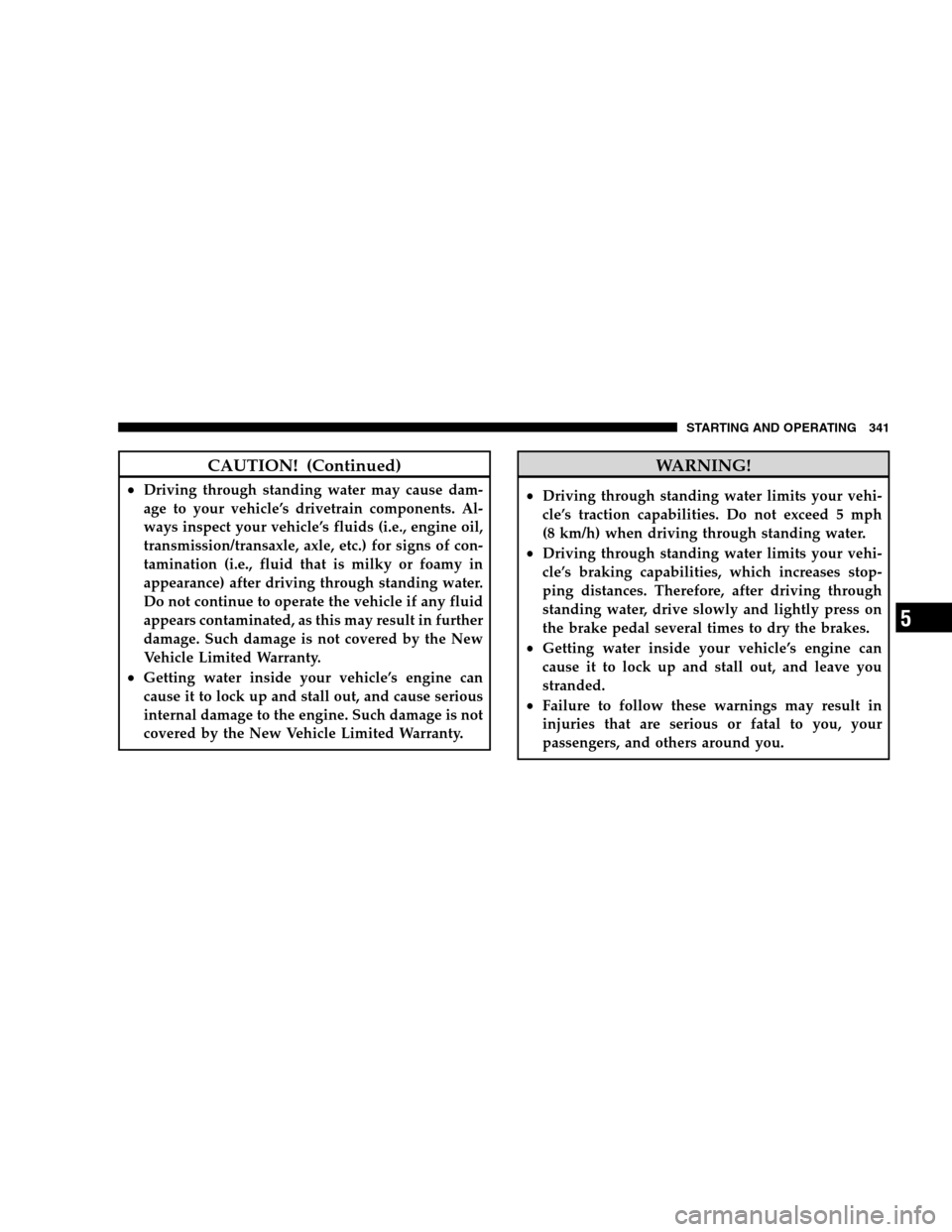
CAUTION! (Continued)
Driving through standing water may cause dam-
age to your vehicle’s drivetrain components. Al-
ways inspect your vehicle’s fluids (i.e., engine oil,
transmission/transaxle, axle, etc.) for signs of con-
tamination (i.e., fluid that is milky or foamy in
appearance) after driving through standing water.
Do not continue to operate the vehicle if any fluid
appears contaminated, as this may result in further
damage. Such damage is not covered by the New
Vehicle Limited Warranty.
Getting water inside your vehicle’s engine can
cause it to lock up and stall out, and cause serious
internal damage to the engine. Such damage is not
covered by the New Vehicle Limited Warranty. WARNING!
Driving through standing water limits your vehi-
cle’s traction capabilities. Do not exceed 5 mph
(8 km/h) when driving through standing water.
Driving through standing water limits your vehi-
cle’s braking capabilities, which increases stop-
ping distances. Therefore, after driving through
standing water, drive slowly and lightly press on
the brake pedal several times to dry the brakes.
Getting water inside your vehicle’s engine can
cause it to lock up and stall out, and leave you
stranded.
Failure to follow these warnings may result in
injuries that are serious or fatal to you, your
passengers, and others around you.
STARTING AND OPERATING 341 5
Page 368 of 535
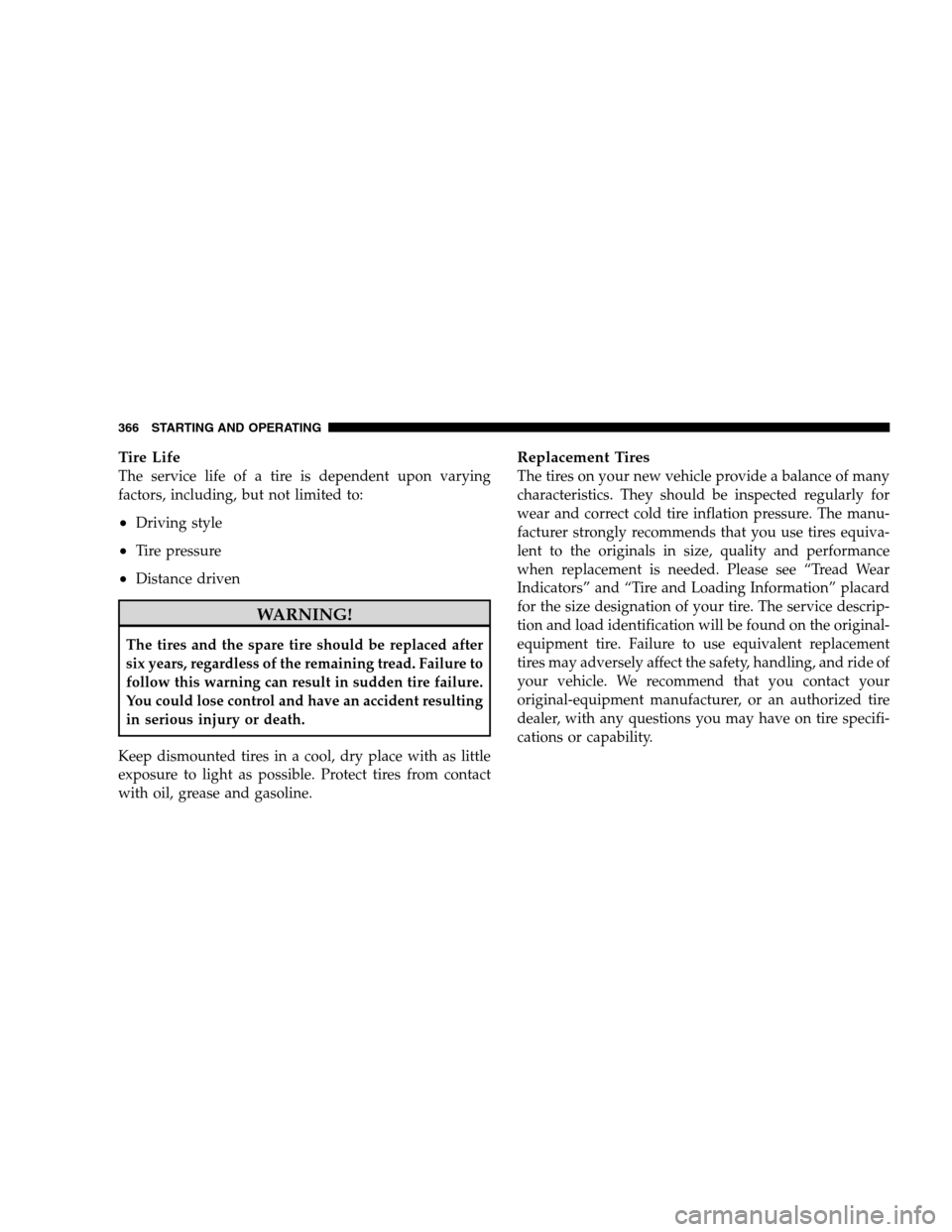
Tire LifeThe service life of a tire is dependent upon varying
factors, including, but not limited to:
Driving style
Tire pressure
Distance driven
WARNING!
The tires and the spare tire should be replaced after
six years, regardless of the remaining tread. Failure to
follow this warning can result in sudden tire failure.
You could lose control and have an accident resulting
in serious injury or death.
Keep dismounted tires in a cool, dry place with as little
exposure to light as possible. Protect tires from contact
with oil, grease and gasoline.
Replacement Tires
The tires on your new vehicle provide a balance of many
characteristics. They should be inspected regularly for
wear and correct cold tire inflation pressure. The manu-
facturer strongly recommends that you use tires equiva-
lent to the originals in size, quality and performance
when replacement is needed. Please see “Tread Wear
Indicators” and “Tire and Loading Information” placard
for the size designation of your tire. The service descrip-
tion and load identification will be found on the original-
equipment tire. Failure to use equivalent replacement
tires may adversely affect the safety, handling, and ride of
your vehicle. We recommend that you contact your
original-equipment manufacturer, or an authorized tire
dealer, with any questions you may have on tire specifi-
cations or capability.
366 STARTING AND OPERATING
Page 382 of 535
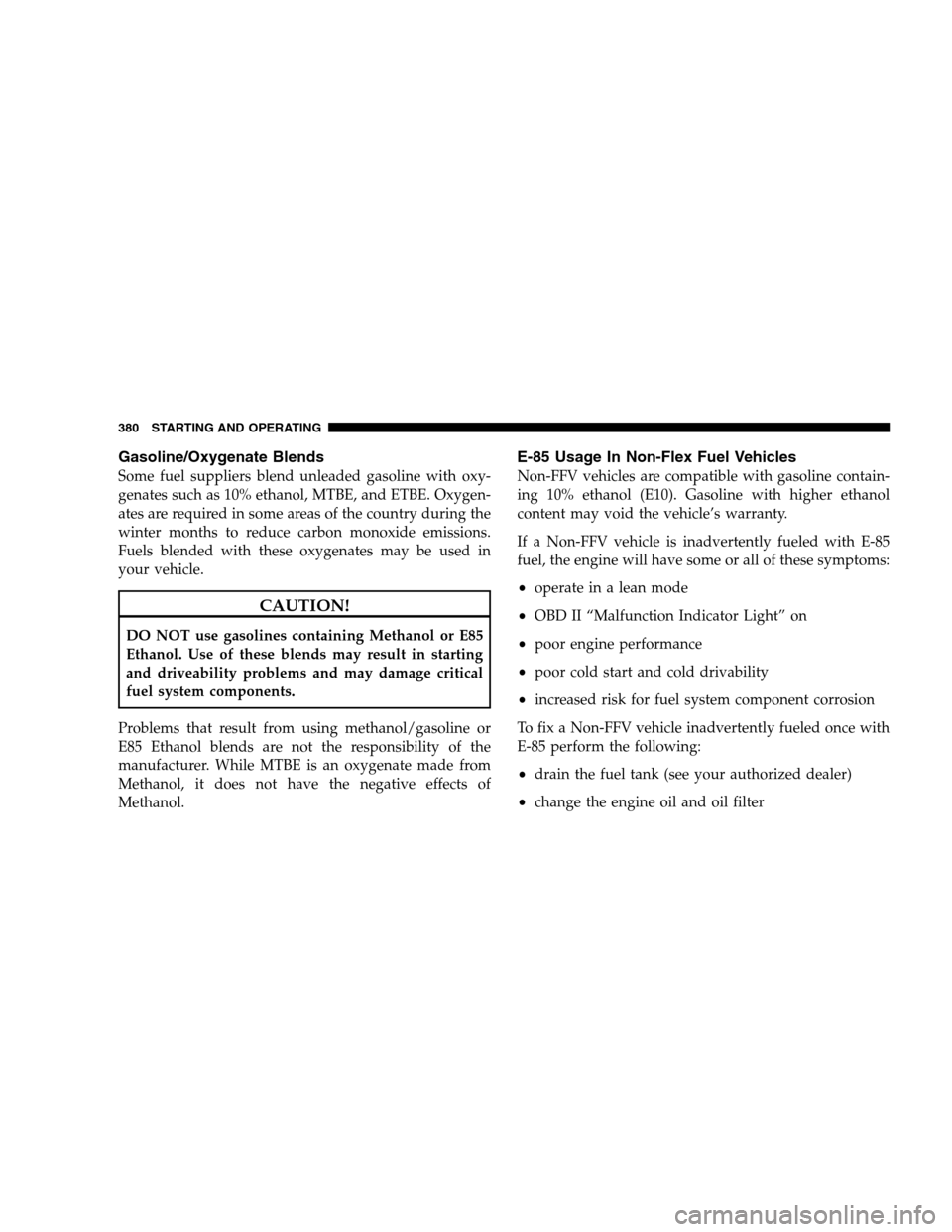
Gasoline/Oxygenate BlendsSome fuel suppliers blend unleaded gasoline with oxy-
genates such as 10% ethanol, MTBE, and ETBE. Oxygen-
ates are required in some areas of the country during the
winter months to reduce carbon monoxide emissions.
Fuels blended with these oxygenates may be used in
your vehicle.
CAUTION!
DO NOT use gasolines containing Methanol or E85
Ethanol. Use of these blends may result in starting
and driveability problems and may damage critical
fuel system components.
Problems that result from using methanol/gasoline or
E85 Ethanol blends are not the responsibility of the
manufacturer. While MTBE is an oxygenate made from
Methanol, it does not have the negative effects of
Methanol.
E-85 Usage In Non-Flex Fuel Vehicles
Non-FFV vehicles are compatible with gasoline contain-
ing 10% ethanol (E10). Gasoline with higher ethanol
content may void the vehicle’s warranty.
If a Non-FFV vehicle is inadvertently fueled with E-85
fuel, the engine will have some or all of these symptoms:
operate in a lean mode
OBD II “Malfunction Indicator Light” on
poor engine performance
poor cold start and cold drivability
increased risk for fuel system component corrosion
To fix a Non-FFV vehicle inadvertently fueled once with
E-85 perform the following:
drain the fuel tank (see your authorized dealer)
change the engine oil and oil filter
380 STARTING AND OPERATING
Page 387 of 535
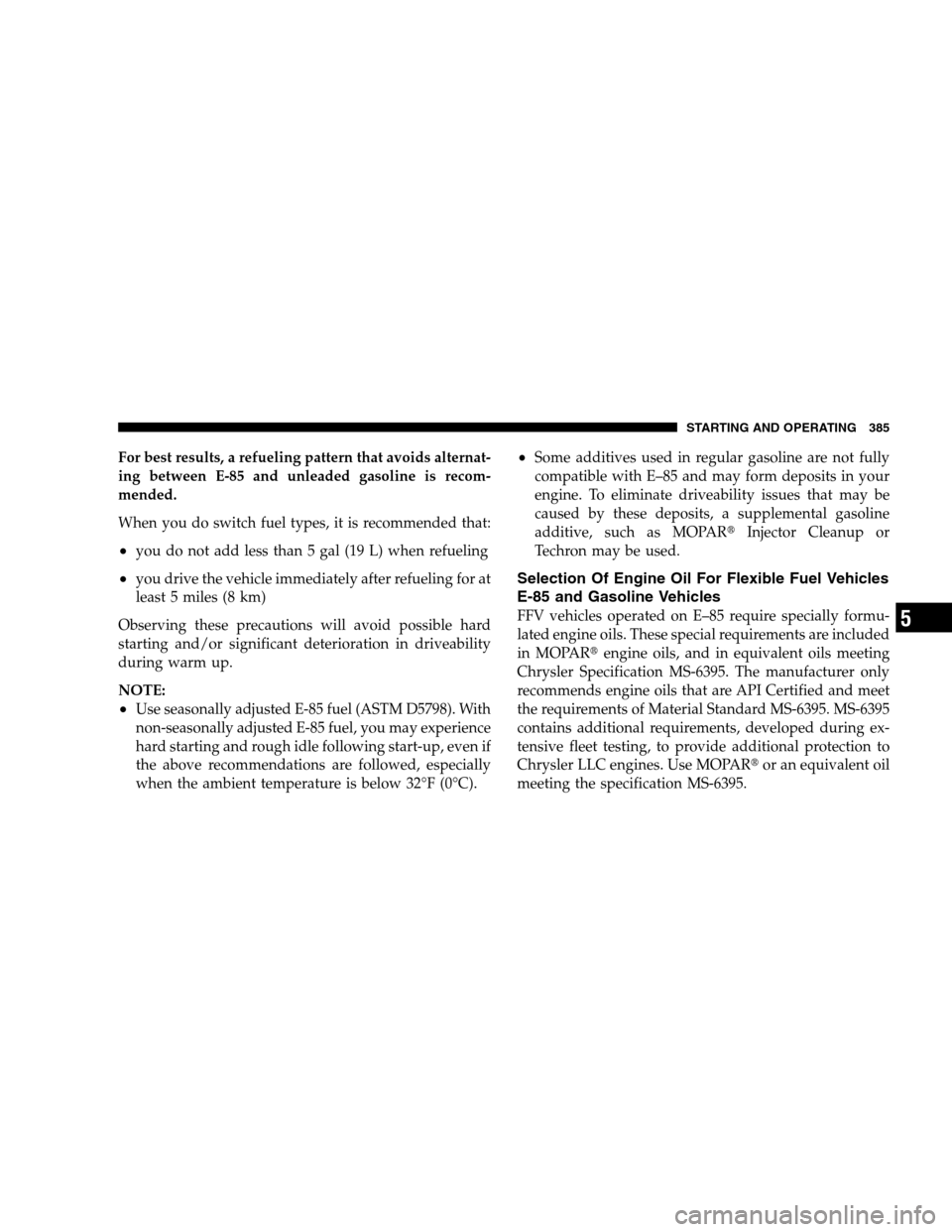
For best results, a refueling pattern that avoids alternat-
ing between E-85 and unleaded gasoline is recom-
mended.
When you do switch fuel types, it is recommended that:
you do not add less than 5 gal (19 L) when refueling
you drive the vehicle immediately after refueling for at
least 5 miles (8 km)
Observing these precautions will avoid possible hard
starting and/or significant deterioration in driveability
during warm up.
NOTE:
Use seasonally adjusted E-85 fuel (ASTM D5798). With
non-seasonally adjusted E-85 fuel, you may experience
hard starting and rough idle following start-up, even if
the above recommendations are followed, especially
when the ambient temperature is below 32°F (0°C).
Some additives used in regular gasoline are not fully
compatible with E–85 and may form deposits in your
engine. To eliminate driveability issues that may be
caused by these deposits, a supplemental gasoline
additive, such as MOPARt Injector Cleanup or
Techron may be used.
Selection Of Engine Oil For Flexible Fuel Vehicles
E-85 and Gasoline Vehicles
FFV vehicles operated on E–85 require specially formu-
lated engine oils. These special requirements are included
in MOPARt engine oils, and in equivalent oils meeting
Chrysler Specification MS-6395. The manufacturer only
recommends engine oils that are API Certified and meet
the requirements of Material Standard MS-6395. MS-6395
contains additional requirements, developed during ex-
tensive fleet testing, to provide additional protection to
Chrysler LLC engines. Use MOPARt or an equivalent oil
meeting the specification MS-6395.
STARTING AND OPERATING 385 5
Page 413 of 535
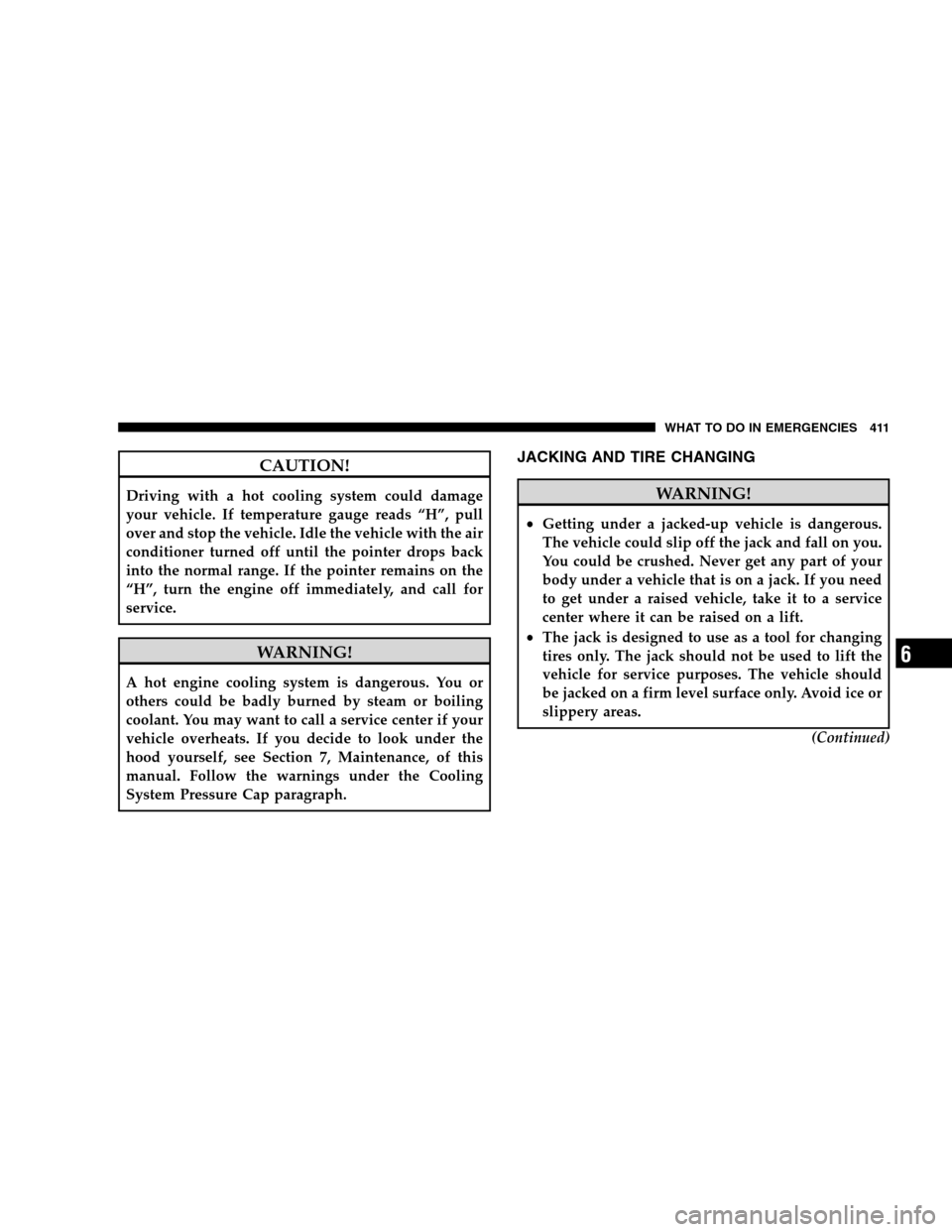
CAUTION!Driving with a hot cooling system could damage
your vehicle. If temperature gauge reads “H”, pull
over and stop the vehicle. Idle the vehicle with the air
conditioner turned off until the pointer drops back
into the normal range. If the pointer remains on the
“H”, turn the engine off immediately, and call for
service.
WARNING!
A hot engine cooling system is dangerous. You or
others could be badly burned by steam or boiling
coolant. You may want to call a service center if your
vehicle overheats. If you decide to look under the
hood yourself, see Section 7, Maintenance, of this
manual. Follow the warnings under the Cooling
System Pressure Cap paragraph.
JACKING AND TIRE CHANGING WARNING!
Getting under a jacked-up vehicle is dangerous.
The vehicle could slip off the jack and fall on you.
You could be crushed. Never get any part of your
body under a vehicle that is on a jack. If you need
to get under a raised vehicle, take it to a service
center where it can be raised on a lift.
The jack is designed to use as a tool for changing
tires only. The jack should not be used to lift the
vehicle for service purposes. The vehicle should
be jacked on a firm level surface only. Avoid ice or
slippery areas. (Continued)
WHAT TO DO IN EMERGENCIES 411 6
Page 433 of 535

MAINTAINING YOUR VEHICLECONTENTS
m
Engine Compartment — 3.3/3.8L . . . . . . . . . 433
m Engine Compartment — 4.0L . . . . . . . . . . . . 434
m Onboard Diagnostic System — OBD II . . . . . 435
▫ Loose Fuel Filler Cap Message — Gascap . . 435
m Emissions Inspection And Maintenance
Programs . . . . . . . . . . . . . . . . . . . . . . . . . . . . 436
m Replacement Parts . . . . . . . . . . . . . . . . . . . . 437
m Dealer Service . . . . . . . . . . . . . . . . . . . . . . . 438 m
Maintenance Procedures . . . . . . . . . . . . . . . . 438
▫ Engine Oil . . . . . . . . . . . . . . . . . . . . . . . . 439
▫ Engine Oil Filter . . . . . . . . . . . . . . . . . . . . 442
▫ Engine Air Cleaner Filter . . . . . . . . . . . . . . 442
▫ Exhaust System . . . . . . . . . . . . . . . . . . . . 443
▫ Maintenance-Free Battery . . . . . . . . . . . . . 445
▫ Air Conditioner Maintenance . . . . . . . . . . . 446
▫ Body Lubrication . . . . . . . . . . . . . . . . . . . 449
▫ Windshield Wiper Blades . . . . . . . . . . . . . 449 7
Page 435 of 535
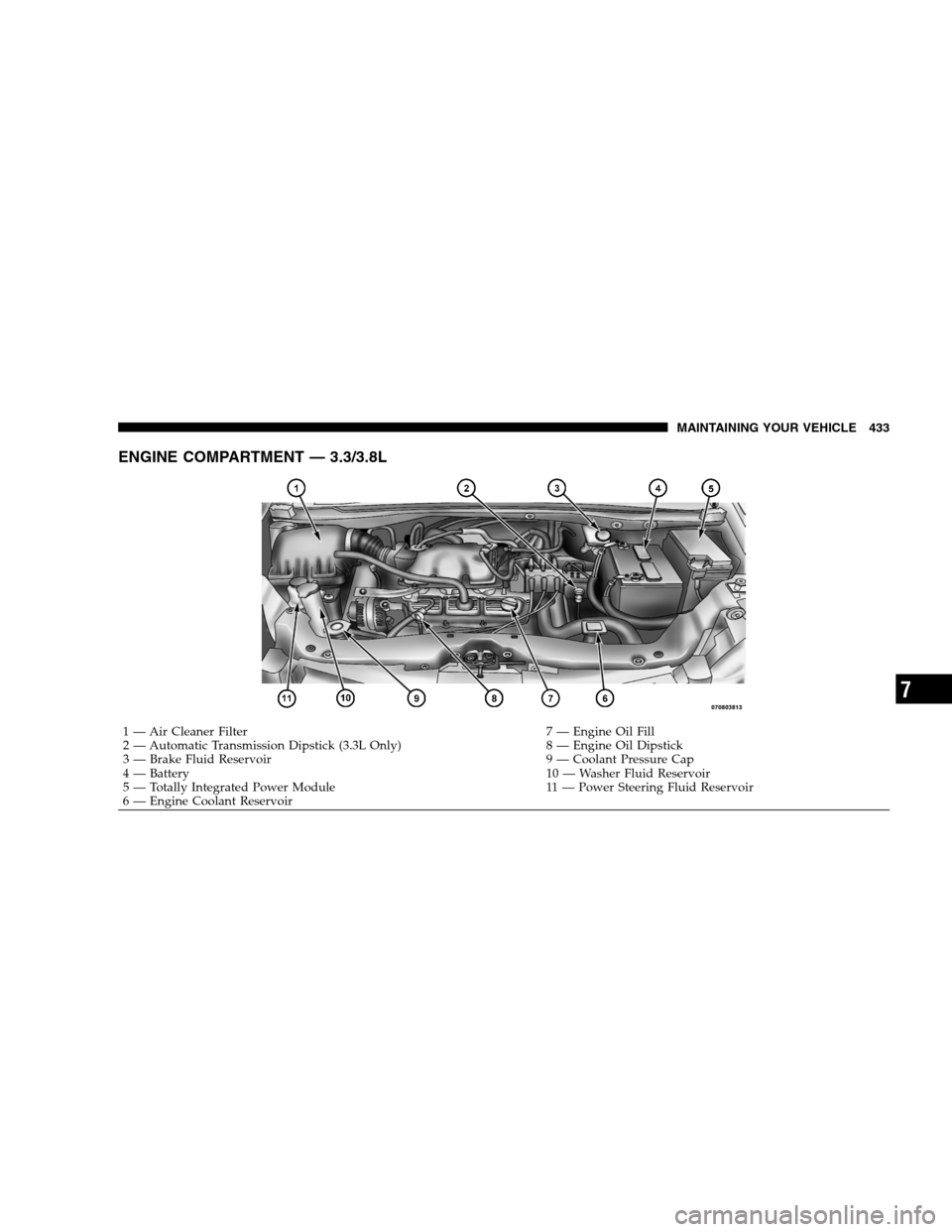
ENGINE COMPARTMENT — 3.3/3.8L
1 — Air Cleaner Filter
7 — Engine Oil Fill
2 — Automatic Transmission Dipstick (3.3L Only) 8 — Engine Oil Dipstick
3 — Brake Fluid Reservoir 9 — Coolant Pressure Cap
4 — Battery 10 — Washer Fluid Reservoir
5 — Totally Integrated Power Module 11 — Power Steering Fluid Reservoir
6 — Engine Coolant Reservoir MAINTAINING YOUR VEHICLE 433 7
Page 436 of 535
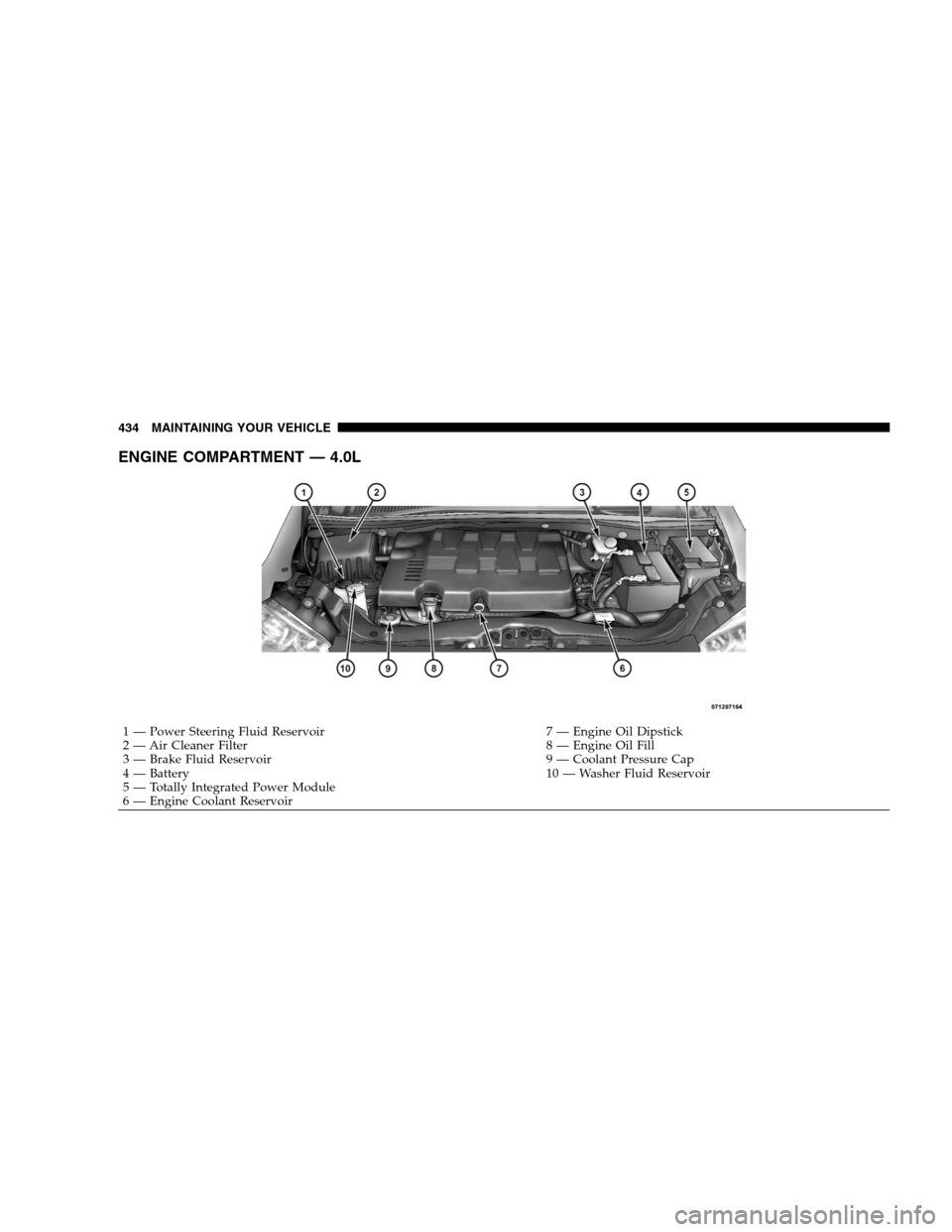
ENGINE COMPARTMENT — 4.0L
1 — Power Steering Fluid Reservoir
7 — Engine Oil Dipstick
2 — Air Cleaner Filter 8 — Engine Oil Fill
3 — Brake Fluid Reservoir 9 — Coolant Pressure Cap
4 — Battery 10 — Washer Fluid Reservoir
5 — Totally Integrated Power Module
6 — Engine Coolant Reservoir
434 MAINTAINING YOUR VEHICLE